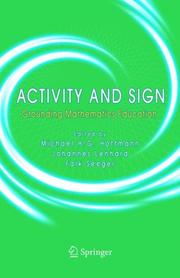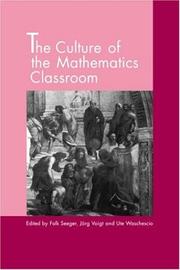| Listing 1 - 10 of 10 |
Sort by
|
Book
ISBN: 3798504679 Year: 1977 Publisher: Darmstadt Steinkopff
Abstract | Keywords | Export | Availability | Bookmark
 Loading...
Loading...Choose an application
- Reference Manager
- EndNote
- RefWorks (Direct export to RefWorks)

ISBN: 1280312017 9786610312016 0387242708 0387242694 1441937110 Year: 2005 Publisher: New York : Springer,
Abstract | Keywords | Export | Availability | Bookmark
 Loading...
Loading...Choose an application
- Reference Manager
- EndNote
- RefWorks (Direct export to RefWorks)
The advancement of a scientific discipline depends not only on the "big heroes" of a discipline, but also on a community’s ability to reflect on what has been done in the past and what should be done in the future. This volume combines perspectives on both. It celebrates the merits of Michael Otte as one of the most important founding fathers of mathematics education by bringing together all the new and fascinating perspectives, created through his career as a bridge builder in the field of interdisciplinary research and cooperation. The perspectives elaborated here are for the greatest part motivated by the impressing variety of Otte’s thoughts; however, the idea is not to look back, but to find out where the research agenda might lead us in the future. This volume provides new sources of knowledge based on Michael Otte’s fundamental insight that understanding the problems of mathematics education – how to teach, how to learn, how to communicate, how to do, and how to represent mathematics – depends on means, mainly philosophical and semiotic, that have to be created first of all, and to be reflected from the perspectives of a multitude of diverse disciplines.
Mathematics --- Study and teaching. --- Philosophy. --- Logic of mathematics --- Mathematics, Logic of --- Mathematics. --- Philosophy (General). --- History. --- Mathematics Education. --- Philosophy, general. --- History of Science. --- Annals --- Auxiliary sciences of history --- Math --- Science --- Mathematics—Study and teaching . --- Mental philosophy --- Humanities

ISBN: 0521571073 0521577985 0511720408 0511822561 Year: 1998 Publisher: Cambridge New York Melbourne Cambridge University press
Abstract | Keywords | Export | Availability | Bookmark
 Loading...
Loading...Choose an application
- Reference Manager
- EndNote
- RefWorks (Direct export to RefWorks)
The Culture of the Mathematics Classroom is becoming an increasingly salient topic of discussion in mathematics education. Studying and changing what happens in the classroom allows researchers and educators to recognize the social character of mathematical pedagogy and the relationship between the classroom and culture at large. The volume is divided into three sections, reporting findings gained both in research and in practice. The first presents several attempts to change classroom culture by focusing on the education of mathematics teachers and on teacher-researcher collaboration. The second section shifts to the interactive processes of the mathematics classroom and to the communal nature of learning. The third section discusses the means of constructing, filtering, and establishing mathematical knowledge that are characteristic of the classroom culture. As an examination of the social nature of mathematical teaching and learning, the volume should appeal both to educational psychologists and to cultural and social anthropologists and sociologists. The editors have compiled a volume that explores not only the acquisition of mathematical knowledge but the communal character of such knowledge as well.
Mathematics --- -Math --- Science --- Study and teaching --- -Social aspects --- Social aspects --- Math --- Study and teaching&delete& --- Health Sciences --- Psychiatry & Psychology --- Social aspects.
Book
ISBN: 3589207310 Year: 1976 Publisher: Königstein/Ts. : Scriptor Verlag,
Abstract | Keywords | Export | Availability | Bookmark
 Loading...
Loading...Choose an application
- Reference Manager
- EndNote
- RefWorks (Direct export to RefWorks)
Mathematics --- Study and teaching --- Textbooks.
Book
ISBN: 3779903024 Year: 1977 Publisher: München Juventa
Abstract | Keywords | Export | Availability | Bookmark
 Loading...
Loading...Choose an application
- Reference Manager
- EndNote
- RefWorks (Direct export to RefWorks)
Book
ISBN: 3761412983 Year: 1990 Publisher: Köln Aulis Verlag Deubner
Abstract | Keywords | Export | Availability | Bookmark
 Loading...
Loading...Choose an application
- Reference Manager
- EndNote
- RefWorks (Direct export to RefWorks)
Book
ISBN: 1281972096 9786611972097 9087905971 9087905955 9087905963 Year: 2008 Publisher: Rotterdam ; Taipei : Sense Publishers,
Abstract | Keywords | Export | Availability | Bookmark
 Loading...
Loading...Choose an application
- Reference Manager
- EndNote
- RefWorks (Direct export to RefWorks)
Current interest in semiotics is undoubtedly related to our increasing awareness that our manners of thinking and acting in our world are deeply indebted to a variety of signs and sign systems (language included) that surround us. Since mathematics is something that we accomplish through written, oral, bodily and other signs, semiotics appears well suited to furthering our understanding of the mathematical processes of thinking, symbolizing and communicating. Resorting to different semiotic perspectives (e. g., Peirce’s, Vygotsky’s, Saussure’s), the authors of this book deal with questions about the teaching and learning of mathematics as well as the history and epistemology of the discipline. Mathematics discourse and thinking and the technologically-mediated self of mathematical cultural practices are examined through key concepts such as metaphor, intentionality, gestures, interaction, sign-use, and meaning. The cover picture comes from Jacob Leupold’s (1727) Theatrum Arithmetico-Geometrico. It conveys the cultural, historical, and embodied aspects of mathematical thinking variously emphasized by the contributors of this book.
Semiotics --- Mathematics --- Study and teaching.
Book
ISBN: 9789087905972 9789087905965 Year: 2008 Publisher: Leiden;Boston Brill | Sense
Abstract | Keywords | Export | Availability | Bookmark
 Loading...
Loading...Choose an application
- Reference Manager
- EndNote
- RefWorks (Direct export to RefWorks)
Digital
ISBN: 9780387242705 Year: 2005 Publisher: Boston, MA Springer Science+Business Media, Inc
Abstract | Keywords | Export | Availability | Bookmark
 Loading...
Loading...Choose an application
- Reference Manager
- EndNote
- RefWorks (Direct export to RefWorks)
Philosophy --- Didactics of mathematics --- Pure sciences. Natural sciences (general) --- wetenschapsgeschiedenis --- didactiek --- filosofie --- wiskunde
Book
ISBN: 9780387242705 Year: 2005 Publisher: Boston MA Springer US
Abstract | Keywords | Export | Availability | Bookmark
 Loading...
Loading...Choose an application
- Reference Manager
- EndNote
- RefWorks (Direct export to RefWorks)
The advancement of a scientific discipline depends not only on the "big heroes" of a discipline, but also on a community's ability to reflect on what has been done in the past and what should be done in the future. This volume combines perspectives on both. It celebrates the merits of Michael Otte as one of the most important founding fathers of mathematics education by bringing together all the new and fascinating perspectives, created through his career as a bridge builder in the field of interdisciplinary research and cooperation. The perspectives elaborated here are for the greatest part motivated by the impressing variety of Otte's thoughts; however, the idea is not to look back, but to find out where the research agenda might lead us in the future. This volume provides new sources of knowledge based on Michael Otte's fundamental insight that understanding the problems of mathematics education - how to teach, how to learn, how to communicate, how to do, and how to represent mathematics - depends on means, mainly philosophical and semiotic, that have to be created first of all, and to be reflected from the perspectives of a multitude of diverse disciplines.
Philosophy --- Didactics of mathematics --- Pure sciences. Natural sciences (general) --- wetenschapsgeschiedenis --- didactiek --- filosofie --- wiskunde
| Listing 1 - 10 of 10 |
Sort by
|

 Search
Search Feedback
Feedback About UniCat
About UniCat  Help
Help News
News